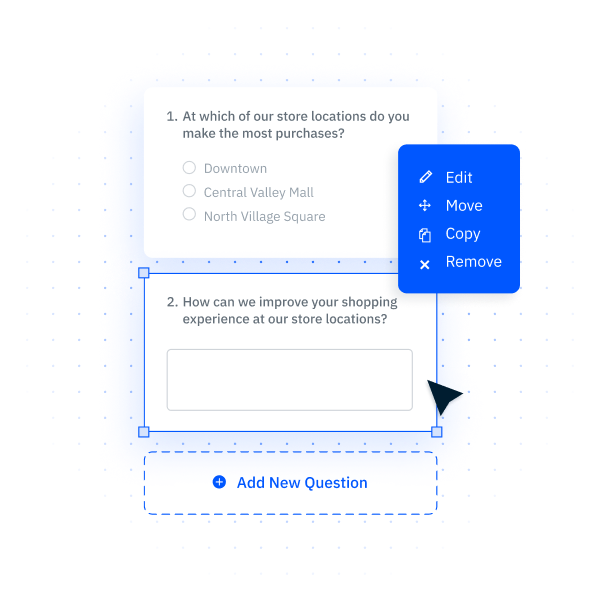How Customer Feedback Can Boost Your Bottom Line
Customer feedback is any information from customers about their experience with a product or service from a specific company. A clear method for gathering and acting on customer feedback is one of the most important steps in creating a complete customer feedback strategy since it shows where companies should focus their efforts to drive long-term growth.
What Is Customer Feedback?
Customer feedback can take many forms, but it is defined as any information from customers about their experience with a product or service from a specific company. This can include the customer’s opinions, complaints, suggestions, and compliments. The goal of customer feedback is to understand and meet customer needs and expectations to improve products, services, and overall customer satisfaction. Businesses can collect feedback actively and passively. But no matter how it is collected, it should drive change and action within the company.
What Is A Customer Feedback Loop?
A customer feedback loop is the complete process of getting feedback, analyzing it, and then responding to it or implementing the feedback into the business. An example of this would be a restaurant collecting customer feedback through surveys, analyzing the responses to identify common complaints about the menu, and then updating the menu items or recipes to better meet customer preferences.
This differs from customer feedback itself because it refers to the entire process of closing the loop, while customer feedback itself just represents the form in which the customer communicates with your organization.
Why Is Customer Feedback Important?
Customer feedback is so important because it connects you with your customers. It can help you identify areas for improvement, as well as highlight strengths. Furthermore, when customers see that their feedback is valued and acted upon, it fosters a sense of trust and loyalty, encouraging repeat business and positive word-of-mouth.
What Are the Benefits of Collecting Customer Feedback?
Businesses should collect customer feedback for several reasons, including measuring customer satisfaction and loyalty, improving products and services, and identifying new opportunities for growth or improvement. On the flip side, not addressing these issues could create negative business impacts, or even leave money on the table. Check out our VoC ROI calculator below to see how much benefit your organization could realize from investing in customer experience and customer feedback!
Collecting customer feedback can aid in many business initiatives such as:
Improve Customer Satisfaction
One of the most visible benefits of gathering and analyzing customer feedback is the improvement in customer satisfaction. Customer feedback can help businesses understand what customers like and dislike about their products or services. By addressing areas of dissatisfaction, businesses can improve the customer experience which increases customer satisfaction.
Improve Business
Customer feedback allows businesses to more quickly and effectively identify problems with their product, services, or experiences. Once the problem has been caught, the business can improve its offerings. By listening to customer feedback, businesses can make changes to their products or services to better meet customer needs.
Identify New Opportunities
Customer feedback can also bring to light new opportunities or ideas for the business, whether that is a new product or a better way of providing customer support. The direct and indirect feedback that a business receives from customers can help identify areas for expansion or new services that customers may be interested in.
Build Customer Loyalty
Customers like knowing that the companies they frequent are interested in hearing and acting on customer feedback. By actively seeking customer feedback and making changes based on that feedback, businesses can build customer loyalty and foster long-term relationships with their returning customers.
Direct vs Indirect Customer Feedback
The two most common categories that customer feedback can be classified as are direct and indirect. While most customer service strategies focus on collecting direct feedback, indirect feedback can offer a more accurate picture of how customers feel about the company as a whole.
Direct Feedback
This type of feedback is provided directly by the customer to the business. It is most often provided through surveys, customer service interactions, and focus groups. Although it shortens the process of collecting feedback, it has the risk of gathering responses that are not as honest since customers may just say what they think the business wants to hear.
Indirect Feedback
Indirect feedback is provided by customers through their behavior and actions. It includes customer reviews, social media comments, and website analytics. Indirect feedback is usually an accurate depiction of how customers feel, but it does require a little more effort to gather and analyze.
Types of Customer Customer Feedback
Your customers can interact with your business in a number of ways. They will almost certainly communicate with you in more than one channel, so it is important to your customer feedback program that you understand all the different types of customer feedback.
Surveys
Surveys can be a powerful and useful tool for collecting customer feedback. A common survey use case would be a post-transactional customer satisfaction survey. Surveys can be used to measure aspects of the customer experience such as quality of the product purchased or the ease of the transaction. One of the great things about surveys is that they can be conducted online, over the phone, or in person. Most often, companies send e-mail surveys for customers to provide feedback about their experience.
Contact Center Interactions
The customer service department, often run out of an omnichannel contact center, is often the first point of contact for customers who have feedback or complaints. Contact center representatives can gather feedback and relay it to the appropriate teams so that the company can adjust its approach in response to customer feedback. A positive experience with the contact center can also improve the customer’s overall satisfaction if their concerns are addressed in a constructive and timely manner.
Social Media
Social media platforms and social media marketing tools are becoming increasingly popular and effective sources of customer feedback. Customers may use social media to share their experiences, both positive and negative. Although social media can be used to gather direct feedback from surveys and polls, most often the feedback will be indirect and qualitative in nature.
Customer Reviews
Finally, customer reviews can be a valuable source of feedback. Reviews can be collected directly on a business’s website or on third-party review sites. These reviews play a significant role in how potential customers view a company, so it is important for businesses to stay active and engaged in monitoring and knowing how to respond to Google reviews as well as any other types of reviews.
How to Analyze Customer Feedback
It is not enough to simply gather as much customer feedback as possible. The true value comes when businesses analyze customer feedback and turn it into action. There are, of course, a few ways to analyze customer feedback. Not all methods of analysis are appropriate for each type of feedback and insight that businesses are looking for, so companies can use any combination of the following based on their needs.
Text Analysis
Text analysis, specifically text analysis software, is a method of analyzing customer feedback that involves using natural language processing (NLP) to extract insights from text data. If a business sends out a survey that includes open-response questions, it may want to use text analysis to identify common themes, sentiments, and topics in customer responses.
Customer Experience Metrics
Many forms of customer feedback offer numbers and ratings that make up customer experience metrics. These metrics are measures used to track the overall satisfaction of customers. The most common customer experience metrics include the Net Promoter Score (NPS), Customer Satisfaction Score (CSAT), and Customer Effort Score (CES).
- Net Promoter Score: The NPS is one of the most straightforward metrics that measures how likely a customer is to recommend the brand to their friends and family. It is usually gathered by asking customers to rate their willingness to recommend the product or service on a scale of one to ten.
- Customer Satisfaction Score: CSAT is also relatively straightforward and measures how happy customers are with the product or service they received. Customers rate their satisfaction with the product or service on a scale of one to five.
- Customer Effort Score: A CES uses a scale from one to seven to determine how easy customers feel it is to interact with the company and use its products or services.
Customer Journey Mapping
The process of customer journey mapping can be a great way to analyze feedback at different touchpoints in the customer journey to identify potential bottlenecks and opportunities for improvement. If a retail business is getting a lot of feedback about poor customer service, customer journey mapping would help them find out if this is happening in-store, or in the post-purchase phase.
How to Develop A Customer Feedback Strategy
A customer feedback strategy works as part of the customer feedback loop. Your customer feedback strategy will be a detailed plan of how your business will go about collecting feedback from your customers, as well as how that feedback is implemented into the business.
1. Define Your Objectives
To develop an effective customer feedback strategy, you need to have a clear idea of what you want to achieve. It is important to start by defining your main objectives. Whether you want to improve customer retention, make product or service improvements, or identify new opportunities, these goals will help you keep a clear purpose when collecting feedback.
2. Identify Feedback Channels
Next, determine which feedback channels make the most sense for your business. These channels should represent the most common ways your customers communicate with you, and where you will have the biggest likelihood of hearing honest feedback. For example, a restaurant may choose to focus on the feedback received from post-transactional email surveys, while an e-commerce business may focus more on online reviews and social media posts. These channels cover areas where each respective business is most likely to hear from and communicate with their customer.
3. Design Effective Feedback Tools
Once your feedback channels have been selected, you need to focus on survey design. Ensure your surveys and questionnaires are concise and focused on specific aspects of the customer experience. When designing your feedback tools, it is useful to have a mix of qualitative and quantitative questions, such as rating scales combined with an open-ended question, to get a holistic view of the customer experience.

4. Implement a Feedback Collection System
Choose the right tools and platforms to collect and manage feedback efficiently. You can use tools such as reputation management software to help streamline the feedback collection process. Regardless of the feedback collection system you use, remember that the most successful feedback methods are ones that can aggregate feedback from multiple sources in one place.
5. Analyze the Feedback
After the feedback is collected, it is time time to analyze what your customers have said. Arguably the most important step in the entire process, this allows you to identify patterns and trends that will lead to actions that will have a positive impact on your business. When analyzing the feedback, use techniques such as sentiment analysis to gauge customer emotions and categorize feedback to pinpoint specific areas of concern or opportunity. Your customers’ feedback is not something that is only analyzed once, it will change over time and will constantly need to be monitored. Be sure to have resources in place that can continuously keep up with what your customers are saying.
6. Close the Feedback Loop
Closing the customer feedback loop involves responding to customer feedback and making necessary changes based on the insights gathered. Knowing how to respond to reviews will help you communicate to your customers that their feedback has been received and is valued. This step also involves outlining to the customer how their feedback is being implemented and following up with them to make sure they are satisfied.
7. Prioritize Business Actions
When your customer or client feedback has been received and analyzed, you may end up with a lot of actions that need to be taken to achieve your previously established goal. List all of the actions you could take, and prioritize them based on the impact on customer satisfaction, the feasibility of implementation, and alignment with business goals. There needs to be a balance of quick wins that will drive immediate success as well as long-term strategic initiatives.
8. Monitor and Measure Results
At the beginning of developing your customer feedback strategy, you should have picked an objective or metric that you were going to measure. After customer feedback has been collected, analyzed, and implemented, it is now time to measure the results against your chosen objective to benchmark performance. As changes are continuously implemented, these metrics need to be regularly assessed to measure the impact of your strategy.
It is possible that you may not see the results you were hoping for, in which case your strategy might need to be updated. This may look like changing your feedback collection methods, your survey design, or the objective you are focused on.
9. Foster a Culture of Continuous Improvement
Customer feedback is most effectively collected and implemented when there is a company-wide culture that values it. Ensure all team members understand the importance of feedback and are equipped to contribute to the feedback process. Furthermore, be sure to celebrate the success of your customer feedback initiatives. Whether it is recognizing an employee mentioned in an online review, or a store location that realized increased customer satisfaction. Making all employees feel a part of the customer feedback process will ensure increased participation and success.
10. Iterate and Adapt
Regardless of your business or industry, customer needs and market conditions are always evolving. To make sure your business does not fall behind, it is important to regularly revisit and refine your customer feedback strategy. Be willing to implement any new feedback channels, tools, or methodologies as you see fit to ensure the continuous success of your customer feedback program.
Best Practices for Collecting Customer Feedback
Collecting customer feedback effectively is crucial for gaining valuable insights that can drive improvements and enhance customer satisfaction. Here are some best practices to ensure you gather meaningful and actionable feedback:
Ensure Anonymity
In some forms of feedback, such as online reviews or social media posts, the customer chooses to let themselves be identified. However, in other forms of feedback, such as email surveys, remaining anonymous is important to the customer and allows them to provide honest and complete feedback. Assure customers that their feedback will be confidential and used solely for improvement purposes.
Focus on Timing
Timing is one of the most critical factors in collecting customer or client feedback. It is best to ask for feedback soon after a customer interaction, such as a purchase or product delivery, while the interaction or experience is fresh in their mind. For feedback that isn’t necessarily based on a recent customer interaction, such as a biannual customer satisfaction survey, it is best to send the survey at a time when your customers will have time to respond.
Thank Customers for Their Feedback
Businesses should also thank customers for their feedback and express appreciation. This can help build customer loyalty and foster long-term relationships with customers. Additionally, repeat customers are more likely to provide honest feedback in the future if they feel that their responses are valued and used to make improvements.
Collect Customer Feedback with InMoment
InMoment’s XI Platform gives you the tools to gather and analyze customer feedback in whatever way works best for your business. InMoment’s tools enable you to stay ahead of your competitors and deliver exceptional customer experiences. Schedule a demo today to see what InMoment can do for you.







